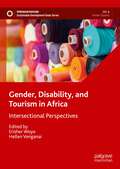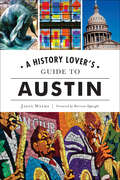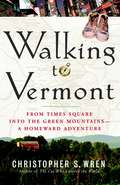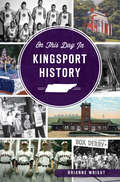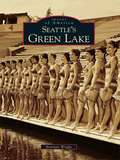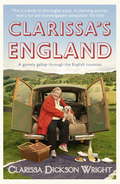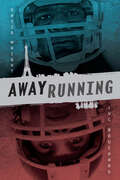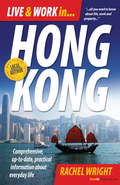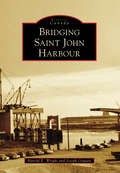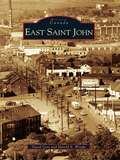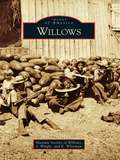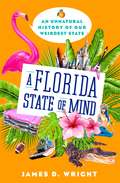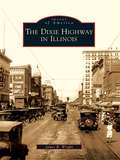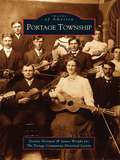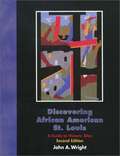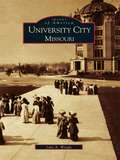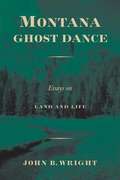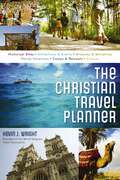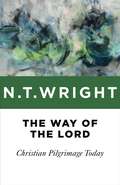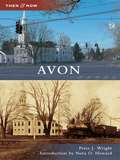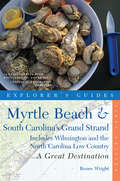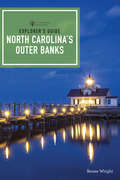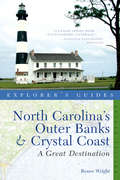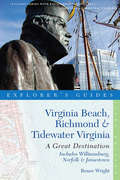- Table View
- List View
Gender, Disability, and Tourism in Africa: Intersectional Perspectives (Sustainable Development Goals Series)
by Erisher Woyo Hellen VenganaiThis book explores the intersection of gender and disability in the context of tourism. In part, the book foregrounds feminist theorising of intersectionality by examining how gender can overlap with other social identities to contribute to more systemic oppression, domination, discrimination, and marginalisation of certain categories of people. Our point of departure is that disability does not operate in isolation as it is constituted and experienced within an already gendered social and tourism environment. With substantial research on the intersection of gender and tourism on the one hand, and the intersection of disability and tourism on the other hand, the interconnectedness of gender and disability and the implications this has on tourism policy and practice remains understudied. Thus, the book provides a critical lens that helps unpack underlying assumptions about gender and disability while questioning the dominant ideas about gender and disability reproduced through tourism policies and institutional practices in an African context. This book will be of interest to scholars and researchers in Gender Studies, Disability Studies, and Tourism Studies, particularly those with a research interest in Africa.
A History Lover's Guide to Austin (History Lover's Guide)
by Jason WreemsDiscover the historic sites and cultural heritage of the Lone Star State&’s Capitol City with this informative and entertaining guide. Now one of the fastest-growing cities in the United States, Austin was once a tiny frontier outpost of Waterloo. With A History Lover&’s Guide to Austin, visitors and locals alike can explore how the &“City of the Violet Crown&” transformed into a world leader in culture and technology. Discover the lost treasure of Shoal Creek in Pease Park or just a sense of inner peace amid the koi ponds and waterfalls of the Zilker Botanical Garden. Like the bats of Congress Avenue, navigate Austin neighborhoods by sound, taking cues from Stevie Ray Vaughan&’s beloved guitar and Angelina Eberly&’s city-saving cannon. From the back streets once stalked by a serial killer to the stately halls of the Texas State History Museum, tour guide Jason Weems charts a course through Austin&’s fascinating history.
Walking to Vermont
by Christopher S. WrenA distinguished former foreign correspondent embraces retirement by setting out alone on foot for nearly four hundred miles, and explores a side of America nearly as exotic as the locales from which he once filed. Traveling with an unwieldy pack and a keen curiosity, Christopher Wren bids farewell to the New York Times newsroom in midtown Manhattan and saunters up Broadway, through Harlem, the Bronx, and the affluent New York suburbs of Westchester and Putnam Counties. As his trek takes him into the Housatonic River Valley of Connecticut, the Berkshires of Massachusetts, the Green Mountains of Vermont, and along a bucolic riverbank in New Hampshire, the strenuous challenges become as much emotional as physical. Wren loses his way in a suburban thicket of million-dollar mansions, dodges speeding motorists, seeks serenity at a convent, shivers through a rainy night among Shaker ruins, camps in a stranger's backyard, panhandles cookies and water from a good samaritan, absorbs the lore of the Appalachian and Long Trails, sweats up and down mountains, and lands in a hospital emergency room. Struggling under the weight of a fifty-pound pack, he gripes, "We might grow less addicted to stuff if everything we bought had to be carried on our backs." He hangs out with fellow wanderers named Old Rabbit, Flash, Gatorman, Stray Dog, and Buzzard, and learns gratitude from the anonymous charity of trail angels. His rite of passage into retirement, with its heat and dust and blisters galore, evokes vivid reminiscences of earlier risks taken, sometimes at gunpoint, during his years spent reporting from Russia, China, the Middle East, Southeast Asia, South America, and Africa. He loses track of time, waking with the sun, stopping to eat when hunger gnaws, and camping under starry skies that transform the nights of solitude. For all the self-inflicted hardship, he reports, "In fact, I felt pretty good." Wren has woven an intensely personal story that is candid and often downright hilarious. As Vermont turns from a destination into a state of mind, he concludes, "I had stumbled upon the secret of how utterly irrelevant chronological age is." This book, from the author of the acclaimed bestseller The Cat Who Covered the World, will delight not just hikers, walkers, and other lovers of the outdoors, but also anyone who contemplates retirement, wonders about foreign correspondents, or relishes a lively, off-beat adventure, even when it unfolds close to home.
On This Day in Kingsport History (On This Day In Ser.)
by Brianne WrightWith a story for each day of the year, Kingsport City archivist and author Brianne Wright illuminates the significant people, places and events of the Model City. Charley Grubb evaded his prison sentence when he slyly escaped from the courtroom during the jury deliberations on May 25, 1929. On June 5, 1936, the Rotherwood Bridge collapse nearly claimed five lives. After four decades, the State Theater officially aired its last film on March 26, 1978. The city's first "Fun Fest," held on August 8, 1981, aimed to bolster community unity. From its early days as Boatyard to the modern-day Kingsport, colorful characters and quirky events shaped the city's unique history one day at a time.
Seattle's Green Lake
by Brittany WrightDiscovered in 1855, Green Lake has been an essential feature within Seattle's distinctive juxtaposition of landscape architecture and urban expansion, providing recreation and community focus for the last 150 years. Named after the persistent algae bloom that still occurs, the lake is a valuable natural landmark at the center of a neighborhood in transition, and its past is threaded with tenacious organizations and ambitious individuals. From its first homesteader, Erhart "Green Lake John" Saifried, to the vision of the Olmsted brothers, from Guy Phinney's menagerie to the triumph and tragedy of Helene Madison, from ice-skating to the Aqua Follies, this broad collection of vintage images illustrates a bygone era and provides a unique perspective on community values and ecological struggle.
Clarissa's England: A Gamely Gallop Through the English Counties
by Clarissa Dickson WrightThe quintessential Englishwoman Clarissa Dickson Wright, one of the Two Fat Ladies and author of Spilling the Beans, takes us on a personal journey through the country of her birth.From Cornwall to Cumbria, Norfolk to Northumbria she brings her extraordinary knowledge, huge passion, forthright opinions and inimitable wit to the distinctive history and regional character of every corner of England.In her cornucopia of local knowledge she reveals, for example, how Boudicca was the original Essex girl, that Lincolnshire has a coriander crop second only in size to India's, and just why a Cornish pasty should never contain carrots.As much an entertaining narrative as it is a travel companion, Clarissa's England will amuse, enlighten, surprise and delight all those who read it.
Away Running
by David Wright Luc Bouchard<p>Matt, a white quarterback from Montreal, Quebec, flies to France (without his parents' permission) to play football and escape family pressure. <p>Freeman, a black football player from San Antonio, Texas, is in Paris on a school trip when he hears about a team playing American football in a rough, low-income suburb called Villeneuve-La-Grande. <p>Matt and Free join the Diables Rouges and make friends with the other players, who come from many different ethnic groups. Racial tension erupts into riots in Villeneuve when some of their Muslim teammates get in trouble with the police, and Matt and Free have to decide whether to get involved and face the very real risk of arrest and violence.</p>
Live and Work In Hong Kong: Comprehensive, up-to-date, practical information about everyday life
by Dr Rachel WrightWhatever your reasons for planning to live and work in Hong Kong, this comprehensive guide will tell you all you need to know to make the most of your time in this vibrant and challenging city. Organised into three sections: Living, Working, and Leisure, this book includes up to date information and well-informed opinion on: * The kind of lifestyle you can expect to enjoy in Hong Kong * The cost of living * Finding accommodation, whether short term or to buy or rent *Having and raising children in Hong Kong *Shopping for food or luxuries - Working and volunteering *Teaching English *Sporting events, special interest groups and the local arts scene *Travelling and places to visit *Entertainment and nightlife
Bridging Saint John Harbour (Historic Canada)
by Harold E. Wright Joseph GoguenIn the 1850s, lumber mill owner W. Kilby Reynolds, with engineer Edward R. Serrell, succeeded in building the first suspension bridge to connect divided Saint John. This operated as a toll crossing until 1858, when it became a government-owned structure. From then until the present, there have been two vehicular-pedestrian bridges and two rail bridges serving travelers crossing Saint John Harbour at the gorge at the Reversing Falls. By the third quarter of the 19th century, there was talk and plans for a second bridge, one which would cross at Navy Island to the North End. It took about 80 years before this plan came to fruition, and the Saint John Harbour Bridge opened in 1968. Through this rich collection of photographs, Bridging Saint John Harbour clearly shows the importance of the varied connector bridges over Saint John Harbour and how they came to be built.
East Saint John (Historic Canada)
by Harold E. Wright David GossEast Saint John, affectionately called the "East Side," became a part of the City of Saint John in 1967. For decades prior to its merger, the city and east side community of the Parish of Simonds cooperated in many areas of municipal service. East Saint John contained many industries, including the dry dock, Foleys Pottery, and McAvitys, and later K. C. Irving's oil refinery at Silver Falls. During World War II , Fort Mispec was established at Mispec Point, and in 1970, the fort site became Irving Oil's Canaport. More than just an industrial area, East Saint John was the site of recreational fishing and boating and home to the neighbourhoods of Forest Hills, Glen Falls, Champlain Heights, and Jean and Belgrave Streets. East Saint John was also the home of the Moosepath raceway, Exhibition Park, and the Simonds Arena. Rothesay Avenue was the commercial heart of the east side until the 1970s, when new malls and shopping centers opened nearby.
Willows (Images of America)
by J. Wright E. Whisman Museum Society of WillowsHot, thirsty range cattle led cowboys to a shady, spring-fed pond midway between the coastal and sierra foothills in Northern California. The area was referred to as "the Willows." It was a place no doubt well known to the native Wintun Indians long before white men came exploring. Settlers began buying up land at $4 an acre after the Gold Rush. Milton French was ranching to the west of town as early as 1857. In June 1876, Johnson and Hochheimer opened a general store. Daniel Zumwalt provided land to railroad magnate Charlie Crocker, who extended train service to the "the Willows" by 1878. Broad streets were laid out in an east-to-west orientation. The town was on its way to becoming the center of one of the most productive agricultural areas in the state, thanks to the development of deep-water wells and the building of canals.
A Florida State of Mind: An Unnatural History of Our Weirdest State
by James D. WrightA witty history of the state that's always in the news, for everything from alligator attacks to zany crimes.There's an old clip of Bugs Bunny sawing the entire state of Florida off the continent—and every single time a news story springs up about some shenanigans in Florida, someone on the internet posts it in response. Why are we so ready to wave goodbye to the Sunshine State? In A Florida State of Mind: An Unnatural History of Our Weirdest State, James D. Wright makes the case that there are plenty of reasons to be scandalized by the land and its sometimes-kooky, sometimes-terrifying denizens, but there's also plenty of room for hilarity.Florida didn't just become weird; it's built that way. Uncharted swampland doesn't easily give way to sprawling suburbia. It took violent colonization, land scams to trick non-Floridians into buying undeveloped property, and the development of railroads to benefit one man's hotel empire.Even the most natural parts of Florida are unnatural. Florida citrus? Not from here, but from China. Gators? Oh, they're from Florida all right, but that doesn't make having 1 per every 20 humans normal. Animals...in the form of roadkill? Only Florida allows you to keep anything you kill on the road (and anything you find). Yet everyone loves Florida: tourists come in droves, and people relocate to Florida constantly (only 36% of residents were born there). Crammed with unforgettable stories and facts, Florida will show readers exactly why.
Dixie Highway in Illinois, The
by James R. WrightThe Dixie Highway, once a main thoroughfare from Chicago to Miami, was part of an improved network of roads traversing the landscape of 10 states. A product of the Good Roads Movement of the early 20th century, construction on the highway in Illinois took place from 1916 to 1921. When completed in 1921, the Dixie Highway was the longest continuous paved road in the state. It ran through parts of Cook, Will, Kankakee, Iroquois, and Vermilion Counties, with service stations, roadside diners, and campgrounds sprouting up along the way. With over 200 vintage photographs, The Dixie Highway in Illinois takes readers on a tour from the Art Institute of Chicago, in the heart of the city on Michigan Avenue, to the Illinois state line east of Danville, exploring this historic highway and the communities it passes through.
Portage Township (Images of America)
by James Wright The Portage Community Historical Society Dennis NormanIt has been over 40 years since the trinity of Crisman, McCool, and Garyton united to become Portage, Indiana. Located 50 miles from downtown Chicago on the shores of Lake Michigan, Portage Township has emerged as a growing residential, commercial, and industrial center. Portage became a town in 1959 and attained city status in 1967, but the region's history begins with the indigenous Wey Indians of the 1700s and the Potowotamie, whose land was sold in 1834. Pioneers then settled the land alongside immigrants. For many generations Portage has offered a new beginning to those who sought work, political asylum, or simply a better life.
Discovering African American St. Louis: A Guide to Historic Sites (Second Edition)
by John WrightAfrican Americans have been part of the story of St. Louis since the city's founding in 1764. Unfortunately, most histories of the city have overlooked or ignored their vital role, allowing their influence and accomplishments to go unrecorded or uncollected; that is, until the publication of Discovering African American St. Louis: A Guide to Historic Sites in 1994. A new and updated 2002 edition is now available to take readers on a fascinating tour of nearly four hundred African American landmarks. From the boyhood home of jazz great Miles Davis in East St. Louis, Illinois, to the site of the house that sparked the landmark Shelley v. Kraemer court case, the maps, photographs, and text of Discovering African American St. Louis record a history that has been neglected for too long. The guidebook covers fourteen regions east and west of the Mississippi that represent St. Louis's rich African American heritage. In the words of historian Gary Kremer, "No one who reads this book and visits and contemplates the places and peoples whose stories it recounts will be able to look at St. Louis in the same way ever again. "
University City, Missouri
by John A. WrightIn 1904, from a plot of land that would soon become University City, eccentric publisher Edwin Gardner Lewis shone the beam of what he claimed was the world's largest searchlight over the World's Fair in nearby St. Louis. Several years later, he claimed an even greater possession: a city, created around his publishing complex, complete with his own mayoral office, wide boulevards, and beautiful residences. The story of University City is one of urban wonder: from the city's "Hilltop Neighbor" and namesake, Washington University, to the diversity showcased in today's University City. The historic images in this volume illustrate the area's founding and development, from the largest printing press of the time, capable of producing 300,000 eight-page newspapers an hour, to the lion sculptures at the city's famed "Gates of Opportunity," standing proud as the city's everlasting symbol.
Montana Ghost Dance: Essays on Land and Life
by John B. WrightMontana has been the last best place for so many people. A century ago, Native Americans gathered here to perform the Ghost Dance--a last, doomed attempt to make white settlers vanish and bring back the old ways of life. Today, people are still pouring into Montana, looking for the pristine wilderness they saw in A River Runs through It. The reality of Montana--indeed, of all the West--has never matched the myths, but this book eloquently explores how the search for a perfect place is driving growth, development, and resource exploitation in Big Sky country. In ten personal essays, John Wright looks at such things as Montana myths; old-timers; immigrants; elk; ways of seeing the landscape; land conservation and land trusts; the fate of the Blackfoot, Bitterroot, and Paradise valleys; and some means of preserving the last, best places. These reflections offer a way of understanding Montana that goes far beyond the headlines about militia groups and celebrities' ranches. Montana never was or will be a pristine wilderness, but Wright believes that much can be saved if natives and newcomers alike see what stands to be lost. His book is a wake-up call, not a ghost dance.
The Christian Travel Planner (Christian Travelers Guide)
by Kevin WrightThe Christian Travel Planner will enable you to plan and prepare for memorable and life-changing experiences. Discussing a multitude of trips, from Holy Land and European pilgrimage tours to mission trips and conference cruises, this book is accessible and user-friendly. Other vacations include fellowship vacations, camps, conventions, adventure vacations, and monastic guest-stays. Complete with stories, must-see descriptions, and website and travel reference information, this planner can also be used as a companion guide while traveling or simply from the comfort of your home, as you explore Christianity's famous sites via the computer. Learn how to begin or enrich a Christian travel ministry at your church, faith community, or organization. The Christian Travel Planner introduces readers to the world of faith-based travel and identifies the plethora of opportunities available to Christians planning a vacation.
The Way of the Lord: Christian Pilgrimage Today
by N. T. WrightVividly evoking the sights, sounds, and smells of the Holy Land, this book by N. T. Wright is ideal for both individual and group study by any readers who have embarked on the spiritual journey of the Christian life.Wright explores all the sites that travelers usually visit on a tour of the Holy Land, explaining not only what is to be seen but also the context of faith that makes these sites, and the events associated with them, famous around the world. By weaving together Old and New Testament stories, poetry, and original insights, Wright helps readers enter imaginatively into each scene. He also sprinkles his narratives with reflections on the nature of pilgrimage generally and with discussion of vital contemporary issues related to the Holy Land.This is a book to be read with Christian pilgrimage in mind, whether one is traveling to the Holy Land physically or merely in heart and mind.
Avon
by Peter J. Wright Nora O. HowardOnce known as Northington, a northern parish of Farmington, Avon was incorporated in 1830 after the construction of the Farmington Canal. Located at the juncture of the Albany Turnpike, the Farmington Canal, and later the Farmington Canal Railroad, Avon became a transportation and commercial center of considerable importance through the 19th century. Avon Historical Society board member Peter J. Wright, with an introduction from town historian Nora O. Howard, illustrates Avon's past and present in vintage and contemporary images.
Live and Work In Hong Kong: Comprehensive, Up-to-date, Practical Information About Everyday Life
by Rachel WrightWhatever your reasons for planning to live and work in Hong Kong, this comprehensive guide will tell you all you need to know to make the most of your time in this vibrant and challenging city. Organised into three sections: Living, Working, and Leisure, this book includes up to date information and well-informed opinion on: * The kind of lifestyle you can expect to enjoy in Hong Kong * The cost of living * Finding accommodation, whether short term or to buy or rent *Having and raising children in Hong Kong *Shopping for food or luxuries - Working and volunteering *Teaching English *Sporting events, special interest groups and the local arts scene *Travelling and places to visit *Entertainment and nightlife
Explorer's Guide Myrtle Beach & South Carolina's Grand Strand: Includes Wilmington and the North Carolina Low Country
by Renee Wright"Consistently rated the best guides to the regions covered...Readable, tasteful, appealingly designed. Strong on dining, lodging, and history."—National Geographic Traveler This new guide covers both Myrtle Beach and its neighbors over the North Carolina border, including the fascinating seaports of Wilmington and Southport, a compact area that takes under three hours to drive from end to end but offers a wealth of different vacation options and activities. Distinctive for their accuracy, simplicity, and conversational tone, the diverse travel guides in our Explorer's Great Destinations series meet the conflicting demands of the modern traveler. They're packed full of up-to-date information to help plan the perfect getaway. And they're compact and light enough to come along for the ride. A tool you'll turn to before, during, and after your trip, these guides include chapters on lodging, dining, transportation, history, shopping, recreation, and more; a section packed with practical information, such as lists of banks, hospitals, post offices, laundromats, numbers for police, fire, and rescue, and other relevant information; maps of regions and locales, and more.
Explorer's Guide North Carolina's Outer Banks (Explorer's Complete #0)
by Renee WrightSee why the Outer Banks is one of the most unique and cherished places in the U.S. The complete guide to North Carolina's stunning coast—some of the most beautiful in North America—is better than ever in this revised, updated, and beautifully redesigned edition. Detailed reviews of lodging, dining, and recreation, plus outfitters, campsites, trails, and point of historic and cultural interest make this book the indispensable companion to the incomparable Outer Banks region. Renowned travel writer Renee Wright makes it easy to get the very most out of your journey to this majestic destination. In addition to the overwhelming beauty of North Carolina's shores, the Outer Banks preserves history and traditions lost to more urban areas of the eastern United States. So, whether it's wild Banker ponies, historic Kitty Hawk, or hidden beaches that visitors would otherwise never find, the gems of the Outer Banks are yours to discover.
Explorer's Guide North Carolina's Outer Banks & Crystal Coast: A Great Destination (Second Edition) (Explorer's Great Destinations)
by Renee WrightLet this guide show you why the Outer Banks is one of the most unique and interesting places in the U.S. to visit. The Outer Banks preserves history and traditions lost to more urban areas of the eastern U.S. Whether it's wild Banker ponies, historic Kitty Hawk, or hidden beaches that visitors would otherwise never find, author Renee Wright leads you to her Wright Choices."
Explorer's Guide Virginia Beach, Richmond and Tidewater Virginia: A Great Destination (Explorer's Great Destinations)
by Renee WrightThe definitive, comprehensive guide to Virginia Beach, Richmond and surrounding areas, with hundreds of lodging, dining, and recreational recommendations. Explore this vital region--Virginia Beach and Richmond, the state capitol. Author Renee Wright offers extensive coverage of Colonial Williamsburg, historic James-town, and Norfolk, home to the great Atlantic Fleet. Includes special sections on Civil War battlefields, maritime history, Hampton Roads' quadricentennial, and bird-watching opportunities in the region.
